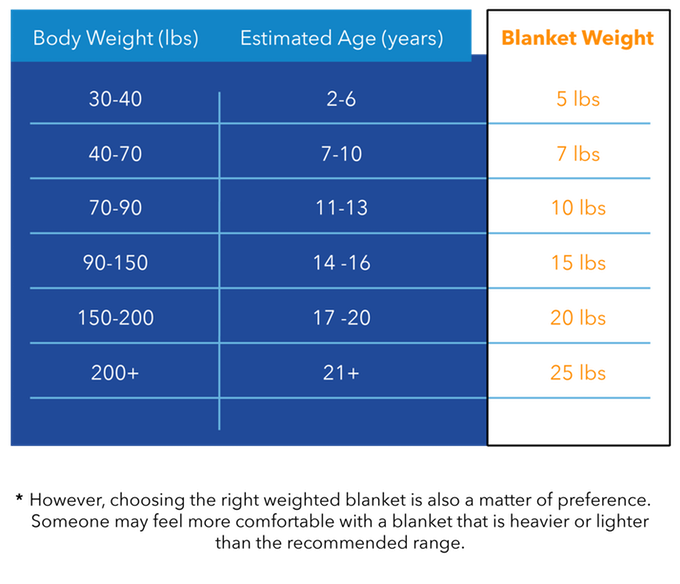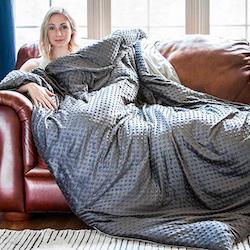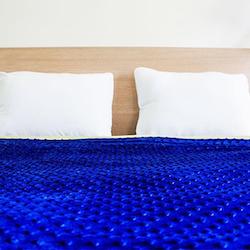Your Cart is Empty

Updated by Molly Shaw Wilson MS OTR/L BCP
Weighted blankets have skyrocketed in popularity over the last two years thanks to their benefits becoming more mainstream.
If you are just hearing about weighted blankets now, don't worry, we'll cover everything you need to know about what weighted blankets are, as well as why they are helping tons of people improve their sleep.
In this article, you'll learn everything listed below:
The interesting thing about weighted blankets is that they have been around and in use for years within the special needs community. This is a typical pattern for therapeutic products. They are used first for those who need them most, then they slowly become mainstream as people realize that they can benefit almost anyone.
The reason they have become mainstream is that people have started to realize that weighted blankets work for anxiety and typical sleep issues, and aren't just for children, but work great for adults.
Most adults, as well as children, could use a little extra help relaxing and improving sleep. In this day and age, where there seems to be a pill for everything, non-drug alternatives are gaining in popularity. Melatonin, vitamin supplements, essential oils, and even CBD oils are used in the general population to combat sleep issues, and weighted blankets are easy to try as well.
You have probably seen weighted blankets advertised on social media streams and available on Amazon. They are currently being sold in big box stores and marketed on Etsy by people who are crafty enough to make their own, personalized versions of them. It’s important to understand why and how they are used, for safety purposes, especially for children. A child MUST be able to easily handle/carry and move out from underneath a weighted blanket safely in order to use it for sleep. They are not indicated for safe use for babies and toddlers.
This article will cover the general overview and benefits of a weighted blanket. However, we love to really cover topics in-depth here at Harkla in order to give you the information you need.
If you want to dive deeper into weighted blankets benefits for specific topics, check out these other articles on our blog:
Before we look at if weighted blankets work or not, let’s go over what a weighted blanket is, in case you are new to them.
A weighted blanket is exactly what it sounds like. It’s a blanket with extra weight in it. However, while they sound simple, there are multiple factors that you'll want to look at when deciding what blanket to purchase.

The material can determine the feeling of the blanket, as well as how easy they are to wash. A weighted blanket can have many different materials that make it heavier. Two of the most common ones you will find are glass beads or plastic pellets. However, you can come across blankets that have rice, millet, or even lead in them (avoid the lead).
At Harkla, our weighted blankets use glass beads so they have a more dispersed, even weight and are very easy to wash. We also use some cotton mixed in with glass beads to give it a more comforter like feeling.
Some weighted blankets are designed as one piece, where the outer layer is also the weighted layer. However, what has become more popular is to have a weighted blanket be two separate pieces, in a duvet style.
Our weighted blankets are designed in a two-piece duvet style. We did this because we wanted washing the blanket to be as easy as possible. Both pieces can be washed and dried, but since we use padding on the inside for more comfort, it can take longer to dry.
With the two-piece setup, you can easily take off the top layer, wash it, and dry it quickly.
The outside material is important to consider when buying a weighted blanket. Maybe you'll want something lighter like a linen, or you'll want more sensory input from a dotted minky blanket.
If you have a duvet style blanket, you can perhaps choose which layer you want, or switch them out depending on the season.
So that’s the general idea of what a weighted blanket is, let's look at how heavy they should be.
The size of your weighted blanket varies based on who you are buying the blanket for. The rule of thumb for getting the right weight is 10% of your body weight plus a pound or two. However, this typically breaks down for heavier adults, as it's hard to find any weighted blanket over 25-pounds.
However, for children, it's very important to use this rule. If your 3-year-old needs a weighted blanket and weighs 40lbs, you’d want to get them a 5lb blanket.
Here is a chart to help you determine how heavy your weighted blanket should be:

The underlying science on weighted blankets is called deep touch pressure (DTP). DTP is about gently applying pressure to the body to increase the release of serotonin.
Serotonin is a chemical in the body that promotes relaxation. What is interesting is that children with autism also tend to be low in serotonin, along with those who have depression, anxiety, aggression, Obsessive Compulsive Disorder, Post Traumatic Stress Disorder, and bipolar disorder. This could be why the effect is much more profound on children with autism, even though deep touch pressure works for most people.
Using weighted blankets on children with or without developmental disabilities is a drug-free way to increase serotonin and elicit a calming effect. Did you know that it can also improve focus? In a classroom setting, students that struggle with attention can benefit from using weighted tools (like a vest or a lap pad) to help them calm and focus - promoting on-task behavior.
So gently applying pressure to the body releases a chemical in your child's brain that promotes relaxation. You can gently apply pressure in a few ways. One way is our weighted blanket. Another way is a weighted compression vest that your child can wear around or when they are feeling upset. Our lap pads are another form of deep touch pressure, as well as our sensory body socks.
They can all be used in different scenarios to take advantage of deep touch pressure in as many realms as possible.

Our first study, from Journal of Medical and Biological Engineering in 2012, looked at how patient's nervous systems reacted when having DTP applied through the use of a weighted blanket. By measuring the subject's nervous system and finding positive results “this study provides physiological evidence to support the positive clinical effects of DTP (deep touch pressure) for reducing anxiety in dental environments.”
This study shows that there is a physiological reaction in a person’s nervous system when DTP is applied. This was specifically for dentist offices since that is a place that causes so many people anxiety!
Sufferers of Restless Leg Syndrome have also found benefits to using a weighted blanket at night. Here, their nervous system is overactive, causing sensations of itchiness or that “pins and needles” feeling. To alleviate this, those with RLS move their legs frequently at night, causing disruptive sleep and negative outcomes throughout the day. The DTP provided through the weighted blanket can help calm the nervous system and offer some relief to RLS sufferers, promoting longer periods of rest and sleep.
Another study from 2012 in Australasian Psychiatry looked at the effect of sensory rooms in an acute inpatient psychiatric unit. They found that when patients used a sensory room, there was a “significant reduction in distress and improvement in a range of disturbing behaviors. Those individuals who used the weighted blanket reported significantly greater reductions in distress and clinical-rated anxiety than those who did not.”
This is great news! Not only did the sensory room, which we’ve talked about before here, reduce anxiety, but those who used a weighted blanket saw an even bigger reduction in anxiety and distress.
A study from Occupational Therapy in Mental Health in 2008 found that when a weighted blanket was used with patients, the majority of them reported lower anxiety.
Individuals with Obsessive Compulsive Disorder can experience some alleviation of stress with the DTP of the weighted blanket. The release of serotonin and associated endorphins can promote a calm and relaxed state, promoting sleep and leaving the individual better able to manage their OCD symptoms.
There are also indicators being released that show positive involvement in using weighted blankets for use in Post Traumatic Stress Disorder. Those with PTSD suffer from symptoms like anxiety, nightmares, heightened reactions, or flashbacks, as well as depression. The drug-free, calming benefits of weighted blankets can foster serotonin release and improved sleep, making their use an easy “tool” for a treatment toolbox in PTSD patients.

This study from the Journal of Sleep Medicine and Disorders from 2015 found that a weighted blanket helped those with insomnia sleep better. Here is a little clip from their results:
“Objectively, we found that sleep bout time increased, as well as a decrease in movements of the participants, during weighted blanket use. Subjectively, the participants liked sleeping with the blanket, found it easier to settle down to sleep and had an improved sleep, where they felt more refreshed in the morning. Overall, we found that when the participants used the weighted blanket, they had a calmer night’s sleep.”
These following studies are about the use of weighted vests, but because they are focusing on the same underlying science of deep touch pressure, they are relevant to our discussion on weighted blankets.
One study focusing on deep touch pressure, or as this study refers to it, Deep Pressure Stimulation, found that using a weighted vest “reduced sympathetic arousal and non–stimulus-driven electrical occurrences.” This means that the pressure from the vest not only mentally calmed down the subjects, but there were physiological reactions to prove the use of the vest.
This one pairs well with our first study referenced in the above weighted blanket section since they both showed positive physiological reactions from the use of DTP.
There are also studies focused on whether or not weighted vests improve children’s focus.
One weighted vest study that focused on children with autism had improved in-seat behavior while using a weighted vest. It should be noted though that there was a period where it didn’t work at first because children enjoyed them so much. They realized that if they acted out, they then got the weighted vest. The researchers used “Noncontingent Reinforcement (NCR)” - this was assessed within the context of a withdrawal design. NCR had an optimal effect on the participants' in-seat behavior.
What they mean by NCR, is that they used the vests long enough to where the children stopped acting out to get them. Once the vests became a part of their normal routines, the researchers could better study how the weighted vests affected the children’s in-seat behavior.
Once they studied children’s behavior after the use of NCR, the children’s in-seat behavior improved.
Another study in 2011 found that using a weighted vest with children who have ADHD improved their in-seat behavior, attention-to-task, and task completion.
The last study we’ll look at is from 2001, which looked at how preschoolers with pervasive developmental disorders reacted to weighted vests. It found that the use of weighted vests decreased the number of distractions while increasing the duration of focused attention.
Did you know Harkla makes weighted vests for children? Learn more here.
This next section is a couple of surveys completed by occupational therapists about the use of deep touch pressure in their practices. Using a weighted blanket in therapy is called, Weighted Blanket Therapy.
A 2004 report that surveyed occupational therapists on their experience using weighted vests found that:
“Although the interviewees observed some different behavioral changes in children with various developmental disorders when these children used weighted vests, their practice patterns in using the vests were similar across disabilities. The most common behavioral changes noted were increased attention and staying on task.”
Another study that investigated OT’s experience with weighted vests with children with autism and ADHD found that “Staying on task, staying in seat and attention span were the most common behaviors that therapists reported improving when weighted vests were used.” For students with ADHD in a classroom setting, focus and attention is a big goal. Having an avenue to try that is calming and drug-free is a nice place to start.
So that’s the collection of studies on weighted blanket benefits, weighted vests, but overall, deep touch pressure. We will be updating this list as more good studies come out.
If you have any questions or comments, please let us know in the comments section! We are here to answer questions and would love to have your feedback!

Hi Mary,
Weighted blankets may help with poor circulation but we recommend that you speak to your doctor.
Thank you,
Nicole from Harkla
Would s weighted blanket help with poor feet circulation . ?
Hi Judy,
Thanks for your question. A person who has experienced a stroke can definitely use a weighted blanket. Remember it is a personal preference so it may or may not help them. It’s always worth trying though! Let us know if you have any other questions.
All the best,
Nicole
Harkla Happiness Ninja
Can a 73 yr. old male that had a stroke use a weighted blanket. would it help for him to relax.
Hey Garnett,
Thanks for your question. Weighted blankets have been known to help with a variety of issues including pain in the legs. Also, they can be very helpful for people who have trouble sleeping. Please let us know how it works for you!
Best wishes,
Nicole from Harkla
I have chronic pain in my back and legs I also don’t sleep well I have a weighted blanket I haven’t used it yet will it help me with any of my problems thanks
Hi Layla,
We’re sorry to hear that! In regards to rashes, it could have to do with stress. It’s not uncommon for stress to activate the immune system in such a way that a person will respond with a rash, most often hives. Let us know if you have any other questions!
Thanks,
Nicole
Harkla Happiness Ninja
Hi Lucy and Kelly,
Weighted blankets may help for both RLS and MS. We’ve had numerous people with both conditions give us feedback about how a weighted blanket has helped them. It never hurts to try!
Thanks for your questions!
Nicole
Harkla Happiness Ninja
Will this blanket help someone with Multiple Sclerosis?
Is the weighted blanket good for restless legs?
Layla, that is probably because once you’ve met one autistic person, you’ve met one autistic person ;)
This particular kid probably doesn’t enjoy the sensation of the additional weight on his body. He might also be hypersensitive to one of the components.
I’ve used a modified weighted blanket with a autism child to decrease his anxiety level to the blanket. He shouted & cried a lot. Within a very short time his face became red & specifically at both eye circle full of rashes. His parents told that he has previous history of the rashes which i didn’t know. Whenever any Occupational Therapist tried to wrap him with weighted blanket, he shouts a lot & rashes exposed. Why so?
Comments will be approved before showing up.


neobest
November 22, 2022
Thank you for sharing,usefu information keep on sharing.